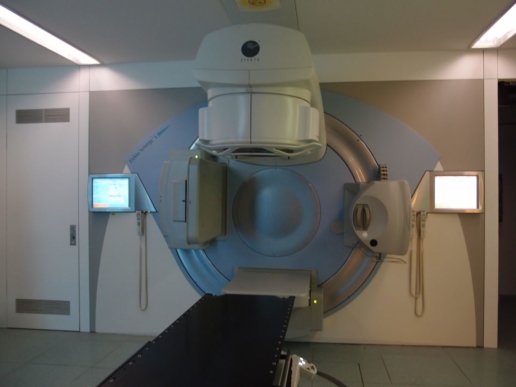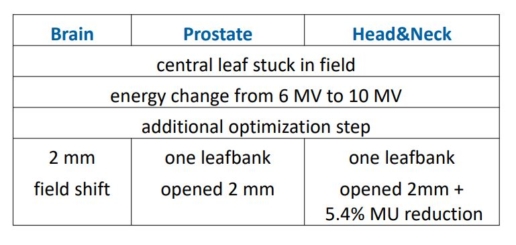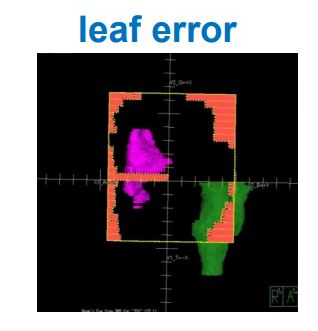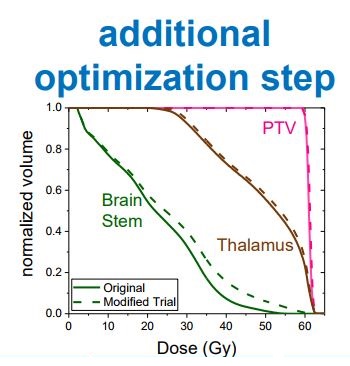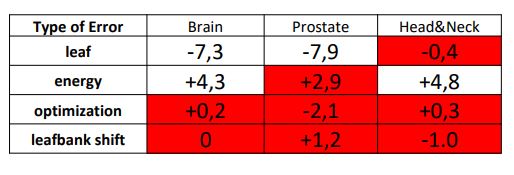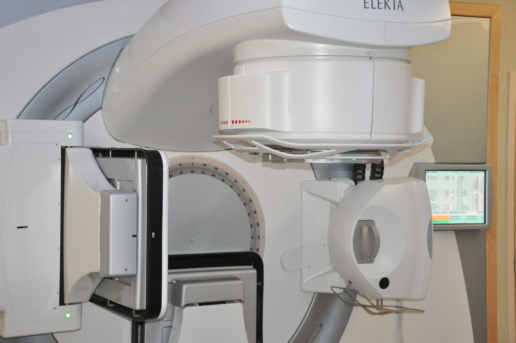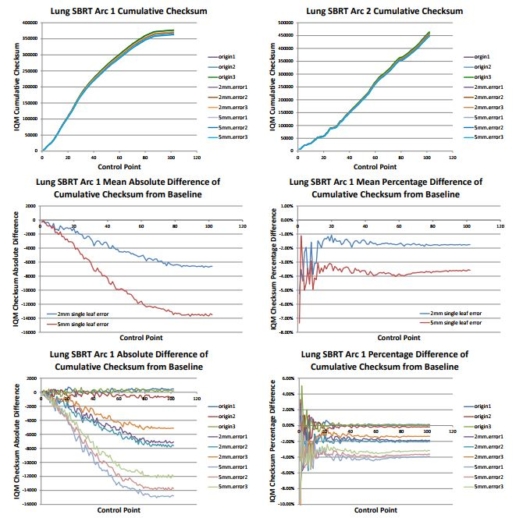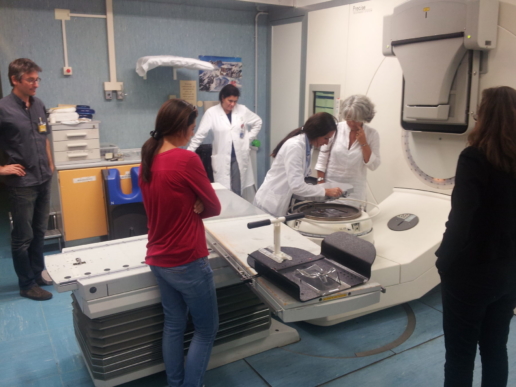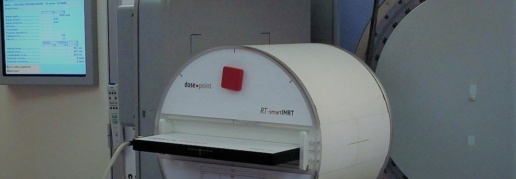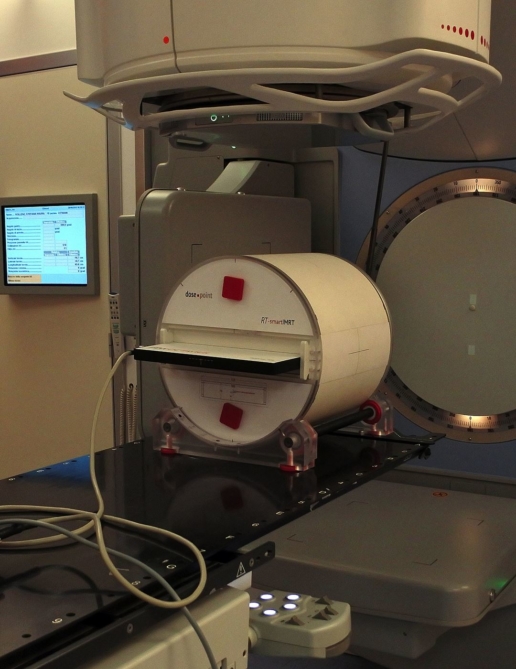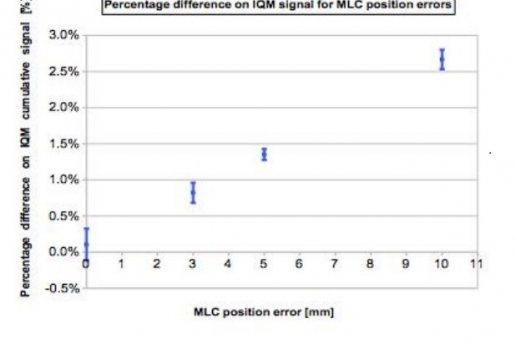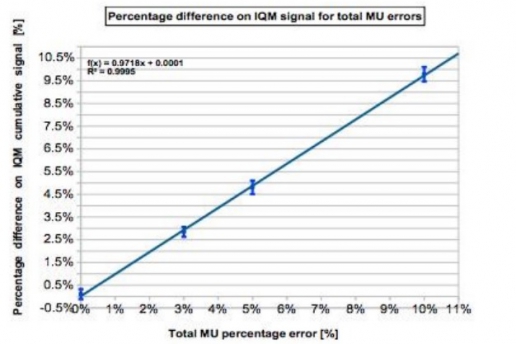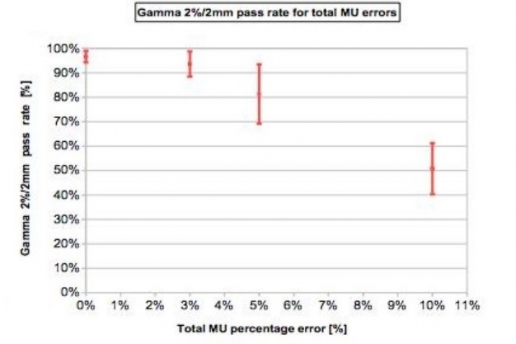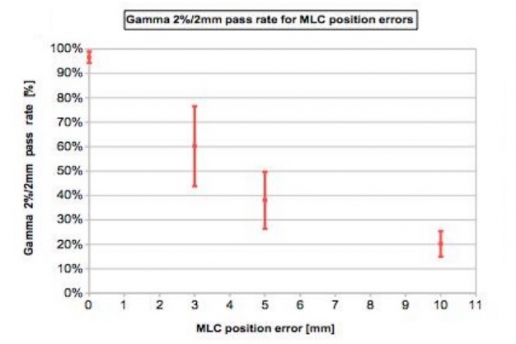Comparison of error detection sensitivity with conventional verification systems
Test purpose
This test series was intended to evaluate the error detection capability of the IQM System for a variety of clinically relevant delivery errors and compare with results of other verification systems.
Test method
Three clinical IMRT plans were modified: Brain, Prostate, Head & Neck. All errors had a clinical effect: DVH parameters of either the targets or organs at risk changed by a few percentages. The plans were measured each with the IQM. The error detection threshold of the IQM System was set to report deviations of 3%. The modified plans were also verified with an ion chamber based cube phantom. The error threshold was defined as +/- 3%. The modified plans were also verified with a Gamma-Index based analysis using a cylindrical phantom. The acceptance criteria were set to 3%/3 mm>98% (2%/2 mm>95%).
Test results
The following tables show for how many beams within each of the 9 field plans deviations were detected by each verification method. IQM detected 11 of 12 errors, the ion chamber & cube phantom method detected 4 of 12 errors, while the cylindrical phantom with gamma index analysis method detected 8 of 12 errors. The error that was not detected by IQM was also not detected by the other two verification systems.
Conclusion
IQM showed the highest error detection rate of all three tested verification systems. During the tests only very limited user interaction was required with the IQM System. The IQM error detection was superior to the other QA procedures.
This test report is based on a publication created by University Clinic, Würzburg (Germany).
Please click on the „Download“ button to download the complete publication.
In-vivo dosimetry of stereotactic radiation treatment
Test purpose
To investigate the feasibility of using IQM for in vivo dosimetry of stereotactic radiation treatment with step-and-shoot intensity modulated radiation therapy (IMRT) or rotational volumetric modulated arc therapy (VMAT).
Test method
Prostate and head-and-neck IMRT and VMAT plans were used to assess IQM constancy in stationary and rotational delivering modes, respectively.
The IQM sensitivity of detecting dosimetric deviations caused by leaf errors in SBRT were evaluated with different plans. Two scenarios of plans were assessed: relatively small and large targets. Single leaf offsets of 2 mm and 5 mm into fields were introduced into the plans. Sensitivity of IQM detecting dosimetric errors in these scenarios were compared with TPS plans and MapCheck2 measurements.
Conclusion
IQM is a stable dosimetric system and can detect dosimetric deviations caused by small leaf errors in stereotactic radiation therapy. IQM sensitivity to leaf errors is more pronounced for relatively small fields (i.e., small targets) in SBRT and IQM appears to be more sensitive than Mapcheck2 to small leaf errors in SBRT for small targets while showing similar sensitivity in SBRT for relatively large targets.
This test report is based on a publication created by Johns Hopkins University, Baltimore (USA).
Please click on the „Download“ button to download the complete publication.
Correlation between changes in IQM signal, Gamma-Index and DVH
Test purpose
Evaluate the correlation between changes in IQM signal, Gamma-Index and Dose Volume Histogram.
Test method
The sensitivity of detecting small delivery errors was checked by inducing seven types of errors in the IMRT clinical plans for head & neck, prostate and the IQM test plan by modifying the number of delivered MU (between 1 and 3 per beam) and by introducing deviations in linac leaf positions mimicking an MLC bank error as closing and opening one or both banks. The influence of those errors on the IQM signal, the change in Gamma Index as well as the influence on the dose volume histogram (PTV V95%) was analyzed.
Conclusion
A good correlation between IQM signal variations and 3D Gamma, 2D Gamma and DVH parameters has been observed.
This test report is based on a publication created by University of Florence, Florence (Italy).
Please click on the „Download“ button to download the complete publication.
Comparing the error sensitivity of IQM with PTW Octavius 729
Test setup
A variety of treatment delivery errors were introduced into 4 clinical H&N VMAT plans.
These plans were applied through the IQM onto a PTW Octavius 729 (local Gamma pass rate: 2%/2mm).
Which of the two systems will be able to detect the errors introduced into the VMAT delivery?
Test method
The errors introduced into the 4 H&N VMAT plans were 3, 5 and 10 % errors on total delivered MUs and with 3, 5 and 10 mm MLCs shift errors.
The cumulative IQM checksum value was measured and the percentage difference was calculated with respect to the non-modified plan. At the same time dose distribution maps were obtained through the PTW 2D array inserted in a rotating QA phantom (RT-smartIMRT, dose.point GmbH). The local gamma pass rates (2%/2 mm) were compared to the original plan values.
Test results
Both methods detect specifically MLC shift errors, while MU variations were better identified by IQM.
IQM shows a linear response with dose (R2=0.9995), while gamma analysis (as used by PTW Octavius) seems to have difficulty in identifying 3% and 5% MU variations.
Conclusion
IQM shows appreciable features in detecting real-time errors and promises considerable time-saving for QA measurements.
This test report is based on a publication created by Azienda Provinciale per i Servizi Sanitari, Trento (Italy).
Please click on the „Download“ button to download the complete publication.
